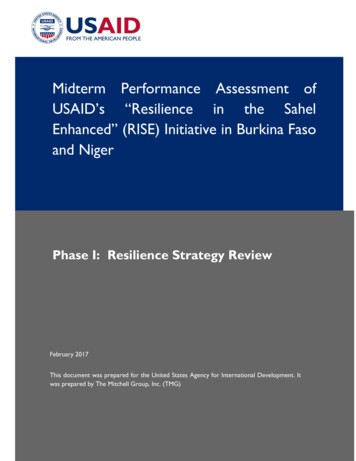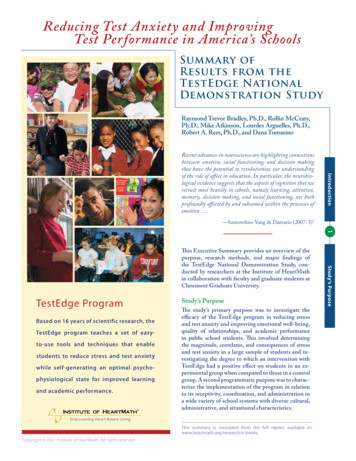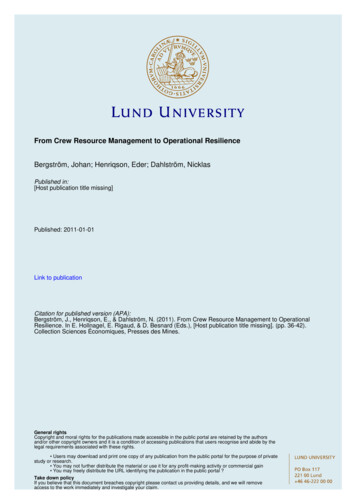
Transcription
GuidepleBuildingPersonal ResilienceSamHeartMath Skillsfor Personal EffectivenessBPR
Building Personal Resilience GuideBuilding Personal Resilience GuideHeartMath Skills for Personal EffectivenessHeartMath LLC(831) 338-8700 www.heartmath.comInstitute of HeartMathe(831) 338-8500 www.heartmath.orgplPublished by Institute of HeartMathCopyright 2014 Institute of HeartMath.All rights reserved. No part of this publication may be reproducedSamwithout the prior written permission of Institute of HeartMath.14700 West Park Avenue Boulder Creek, Calif. 95006 USA(831) 338-8500 Fax (831) 338-8504 www.heartmath.orgThe content, tools, techniques of this program were made possible by the research completedat the IHM Research Center. This work is made possible by the generosity of our donors.The Institute of HeartMath is a nonprofit, charitable organization founded in 1991.This manual is a work prepared in conjunction with programs offered by the Institute of HeartMath (IHM).In no event shall IHM have any responsibility or liability for any consequences of any use, misuse, inabilityto use, or reliance upon the information contained herein, nor does either warrant or otherwise representin any way the accuracy, adequacy, or applicability of the contents hereof. 2014 Institute of HeartMath. All rights reserved. HeartMath, The Resilient Educator, Freeze Frame, Early HeartSmarts, HeartSmarts and HeartLock-In are registered trademarks of the Institute of HeartMath. Depletion to Renewal (Emotional Landscape) is a trademark of HeartMath LLC.TestEdge is a registered trademark of HeartMath LLC. Inner-Ease, Coherent Communication, Heart-Focused Breathing, Resilience Advantage,Coherence Advantage and Building Personal Resilience are trademarks of Doc Childre. Quick Coherence is a registered trademark of DocChildre. emWave and emWave2 are registered trademarks of Quantum Intech, Inc. The emWave Pro is an educational system. It is not classifiedas a medical device and should not be used for medical diagnostic purposes. However, the emWave does capture accurate real-time heartrhythms and heart-rhythm coherence information showing how emotions affect heart rhythms and autonomic nervous system balance.ii Copyright 2014 Institute of HeartMath
Table of ContentsTABLE OF CONTENTSIntroduction . ivWhat is Resilience? .1The Four Domains of Resilience .4Energy-Draining Situations/Events Exercise (Worksheet) . 6Energy-Renewing Situations/Events Exercise (Worksheet) . . 7Depletion to Renewal Grid.8eDepletion to Renewal Grid – Worksheet. 10Three Strategies for Building and Sustaining Resilience .11pl1. Prep . . 122. Shift and Reset. 12Sam3. Sustain . . 13Heart-Focused Breathing Technique .14Coherence .15Quick Coherence Technique. 18Inner-Ease Technique. 19Heart Lock-In Technique. 21Making Effective Decisions.22Freeze Frame Technique . 24Freeze Frame Exercise (Worksheet) . 26Effectively Communicating in Challenging Times .27Coherent Communication Technique . 29Action Plan for Plugging Energy Leaks .30Action Plan for Building Resilience Capacity .31 Copyright 2014 Institute of HeartMathiii
Building Personal Resilience GuideIntroductionYour HeartMath coach or mentor will use this guide to introduce you to simple, practicaltechniques that can help you de-stress from challenging situations, big or small. You’ll learnstrategies to build your resilience and boost your ability to “take charge” of yourself by better regulating your energy throughout the day, a key in building and sustaining your resilience. Exploring theenergy-management concepts can help you see where you may be draining your energy and depleting your reserves, which can keep you from being your best. You may discover in some cases thesource of your stress is not what it may appear to be.Of primary importance is practicing the science-based techniques you will learn that change theway your body’s physiology responds in stressful situations. Then, automatic stress reactions won’tedictate how you feel, respond or perform, whether you’re at work or at home.SamplIt’s important to recognize that we all experience moments when we feel in sync and“on top of the world,” when we enjoy projects and interactions with family, friends and colleagues.Certain events and interactions, though, can disrupt those feelings. The techniques you will learncan help you get back in sync and back on track faster, right in the moment. No one will even knowyou’re using them!We’ll ask you to practice these techniques often during the program so they become more familiar and automatic, which will help to build your resilience and give you the ability to maintain yourcomposure and clarity, even in more challenging situations. We’ll help you understand when andhow to apply the techniques. We’ll also see how to Prep for, Shift and Reset and also how to Sustainyourself during and after any challenging situation or interaction.There are three keys to getting the most out of this program:1. Review the Building Personal Resilience Guide frequently. It contains all the resiliencebuilding techniques and important concepts covered in the program.2. Consult with your coach or mentor, who is here to support and encourage you asyou learn how to apply the techniques to your specific challenges and situations.3. Make a commitment to yourself to practice the techniques recommended.Let’s get started by first looking at resilience and energy management so you can better understandhow to optimize your performance and respond appropriately to any situation, even the toughones.iv Copyright 2014 Institute of HeartMath
CoherenceCoherenceOverview:Goal: Understand the concept of coherence and how it relates to resilienceand performance.Key Concepts: Coherence is an optimal state of functioning. Coherence is the key to building your resilience capacity.e The more coherence you build and maintain, the more energy you buildand store in your system. You create a new baseline of resilience. Renewing emotions create the measureable state of coherence.pl Negative emotions are costly and inefficient and deplete your resiliencecapacity.SamGaining and maintaining the coherence advantageThere are times in our lives when we have experienced periods of being in syncand flowing with a sense of ease through whatever challenges come our way.When we are in that coherent flow, things that come up just don’t seem to get underour skin. We are firing on all cylinders. That is what coherence is all about: The heart,mind, emotions and body are all working in sync. When this happens, we are ableto “take charge” of ourselves and maintain our composure. We have more energy,time seems to pass by quickly and we seem to flow through or around issues. Whenchallenges come up, we can think more clearly, keep our cool, do what we need to doand move on. We have more energy and more stability.Our ability to stay in an inner state of ease and flow through the day is determined byour ability to self-regulate our emotions and stop energy leaks. The first step to intelligent energy self-regulation is identifying where the biggest areas of unnecessaryenergy expenditure are occurring.Think of energy as water in a bucket. If there are holes in the bucket allowing water toleak out, you have to know where they are before patching them. It makes sense toplug the biggest holes first. Copyright 2014 Institute of HeartMath15
Building Personal Resilience GuideFrom an energy-management perspective, depleting emotions arecostly and inefficient. They are the big holes in the bucket. Thebigger the stress reaction, the bigger the drain is on our energy.The accumulation of smaller reactions throughout the day can have asignificant energy draining affect and waste more energy thana big blowout. Refer to the exercise you did on page 6,Energy-Draining Situations.pleThere is important research showing that when you’reunder stress and experiencing depleting emotions like frustration and anger, you generate incoherent or chaotic signals in your heart rhythms. This limits the brain’s ability to process informationaffecting decision-making, problem-solving and creativity. Reaction speed slows and coordinationis impaired. This helps explain why it’s difficult to think clearly and respond effectively when you’refeeling angry or irritated: It’s because you have drained a lot of energy and because the heart issending chaotic signals to key brain centers.SamThese graphs illustrate how stress reactions and positive states affect the nervous system differently. Topgraph: the typical heart-rhythm pattern that occurswhen we are frustrated or stressed. The chaotic andjerky pattern shows that the signals in the nervoussystem are out of sync. This negatively affects mentalfunctions and reaction times. Bottom graph: thetypical heart-rhythm pattern that occurs when weare in a positive state such as appreciation, creatinga coherent system. Copyright 2014 Institute of HeartMathYou can learn to generate coherent or “smooth” signals by experiencing renewing emotions likeappreciation and patience. Coherent heart rhythm signals coming from your heart actually helpthe brain process information more efficiently. In other words, you can think more clearly andmake better decisions when you are coherent.The Emotions and Heart Rhythms diagram above shows two actual heart-rhythm patterns of aman. The top, chaotic-looking image, called an incoherent pattern, reflects when he was feelingfrustration. The bottom image, or coherent pattern, was generated when he felt appreciation. Thetechniques you are learning will enable you to make that shift from an incoherent heart rhythm toa coherent rhythm, which is the foundation for intelligent energy self-regulation, optimal performance and mental clarity.16 Copyright 2014 Institute of HeartMath
CoherenceRemember, it’s renewing emotions that add energy to your reserves,but it takes more than thinking positive thoughts. Actually feelingpositive or regenerative emotions is what creates coherence. Whenyou use the energy-management techniques in this guide, youwill begin plugging leaks and recharging your battery. Generatingcoherence even for a few minutes brings your physical, mental andemotional systems into alignment.Coherence, an optimalphysiological state, isthe essential key tobuilding resilience andis one you can selfgenerate using thetools in this guide.Benefits of Coherence: Plugs energy leaks Optimizes performancee Builds resilience capacity for faster recovery from physical, mental andemotional stressorspl Develops faster reaction times and better coordination Helps increase capacity to be in charge of reactions Aligns the body’s systems to work in sync with less wear and tearSam Increases ability to think more clearly, stay focused and make better decisions Enhances ability to recover more quickly from physical, mental and emotionalstressors Facilitates better sleepThe following techniques can help create a feeling of greater ease and balance while pluggingenergy leaks by creating more coherence in your system. We’ll also show you how to make themost of the energy-renewing situations and the feelings you associate with them that youidentified earlier. Copyright 2014 Institute of HeartMath17
The Institute of HeartMath is a nonprofit, charitable organization founded in 1991. This manual is a work prepared in conjunction with programs offered by the Institute of HeartMath (IHM). In no e










